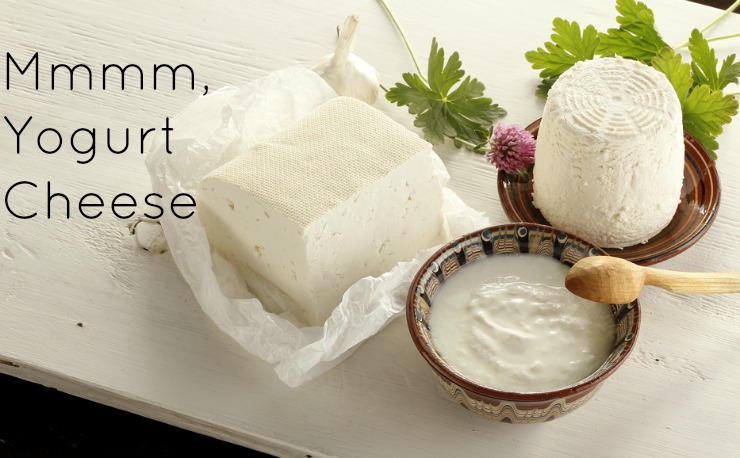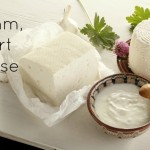 I received a number excited emails from readers regarding the recent article on cheese making. It seems that there are some home fermenters out there who have mastered the basics of kombucha and sauerkraut and are eager to expand the repertoire to include healthy, nutritious cheese.
I received a number excited emails from readers regarding the recent article on cheese making. It seems that there are some home fermenters out there who have mastered the basics of kombucha and sauerkraut and are eager to expand the repertoire to include healthy, nutritious cheese.
I am a firm believer in early success when it comes to trying something new in the kitchen. This minimizes discouragement which can lead to the resurgence of old habits or relying on lower quality convenience foods. Success with a traditional food technique also increases the probability that the new skill will become part of your regular kitchen routine.
Therefore, if making cheese is your goal, I would suggest starting with the most easiest cheese I’ve ever attempted: yogurt cheese. If yogurt cheese sounds like something you’d like to try, there are four basic decisions to settle on before you get started:
- Will you use store bought or homemade yogurt?
- Will you use raw or pasteurized yogurt?
- Will you use yogurt or kefir, or some other fermented dairy?
- Will you use dairy or nondairy yogurt?
Then again, you can just save yourself all the trouble and buy yogurt cheese (where to find). But, you won’t get the satisfaction of learning how to make this most basic of cheeses yourself, not to mention the budget busting price of quality cheese these days.
Store Versus Homemade Yogurt
You don’t need any special type of yogurt to make yogurt cheese. Plain, whole milk yogurt from the store will do just fine although you will certainly obtain a nutritionally superior cheese if you make homemade raw yogurt with grassfed raw milk or purchase raw yogurt from a local pastured dairy.
If you plan to buy store yogurt for your first attempt at making yogurt cheese, I recommend seeking out quality grassfed yogurt like this brand. This is the brand I used for years before I finally started making my own or buying from a local dairy. Just be sure that the yogurt is plain and that it is whole milk and not lowfat especially if you are trying to get pregnant or are already expecting. This is because fertility is lowered eating lowfat dairy and babies born to mothers eating lowfat yogurt are more likely to develop asthma.
Yogurt Cheese Can Be Pasteurized or Raw
As it turns out, the process of making raw yogurt cheese or pasteurized yogurt cheese is exactly the same. The process is exactly the same whether you are using Greek or regular yogurt as well. The only difference is that raw yogurt cheese will be a bit softer and easier to digest due to the presence of additional enzymes that were not destroyed by the pasteurization process. The most important enzyme present in raw yogurt cheese that is not present in pasteurized yogurt cheese is lactase which faciliates digestion of lactose (yes, if you have a lactose intolerance, you can probably consume raw yogurt cheese and other raw dairy products!).
In addition, the enzyme to absorb the precious calcium so bio-available in yogurt cheese has been destroyed if you use pasteurized yogurt. This means your digestive system has to produce it or you won’t absorb it. This is why people who consume pasteurized dairy may still suffer from osteoporosis, but those who consume raw dairy are more greatly protected.
Can Kefir Be Substituted for Yogurt?
If you would prefer to use kefir instead of yogurt to make cheese, by all means do so.
On the upside, kefir has many more strains of probiotics than yogurt, but on the downside, the resulting kefir cheese will be much stronger tasting and perhaps not as pleasant to eat. The important and significant probiotic differences of kefir vs yogurt are discussed in the linked article.
Non-Dairy Yogurt Cheese
If you have a dairy allergy, you can substitute coconut yogurt or coconut kefir. If you are going to make it yourself, I would recommend using coconut kefir as it produces more consistent results. You can buy plain coconut milk yogurt at the store if you’d like to keep things as simple as possible.
Once you’ve decided what type of yogurt you are going to use to make your yogurt cheese (raw vs pasteurized, store vs homemade, dairy vs nondairy), the rest is easy!

Yogurt Cheese Recipe
Yogurt cheese is a soft, mild, flavorful cheese that is simple to make with a quart of plain yogurt from the store. Full of probiotics and enzymes!
Ingredients
- 1 quart Plain, whole milk yogurt
Instructions
-
Spread a white, cotton dishtowel evenly in the bottom of the glass bowl (I use this one). Scoop or pour the yogurt into the middle of the dishtowel.
-
Gather up the ends and tie securely with the rubber band. Attach the rubber band to a knob or other fixture on one of your upper cabinets with the bowl underneath to catch the drips.
-
Allow the liquid whey to drain out of the yogurt. This will take several hours. Greek yogurt will take about half the time to drain as regular yogurt.
-
When there is no longer any whey dripping out of the yogurt cheese bag, remove the bag from the kitchen fixture and place on the counter. Remove the rubber band and lay the dishtowel out flat.
-
Scoop the yogurt cheese which will have a firm but moist texture into a container (preferably glass), affix a lid and refrigerate.
Recipe Notes
Equipment
1 plain white cotton dishtowel, flour sack cloth or tight weave cheesecloth
Large rubber band
How to Enjoy Yogurt Cheese
Yogurt cheese is delicious on bagels instead of processed cream cheese or as a base for dips. Mix in some fruit or herbs to add flavor variety.
You can also use it to make no bake cheesecake as a healthy substitute for that nasty, additive filled cream cheese from the store!
Yogurt cheese also makes a great filling for lasagna.
Yogurt Cheese Video Demonstration
Below is a video of how I make yogurt cheese in my home. The resulting liquid whey left in the glass bowl can be used as a probiotic rich starter for fermenting your favorite vegetables. Don’t know where to start? Try basic sauerkraut or the digestive tonic beet kvass.
I promise you, once you make your first batch of yogurt cheese, you will be delighted at how easy it is. Making yogurt cheese is also a great activity with the kids in the kitchen because it only requires a few simple steps and they can enjoy eating the results!
Happy cheese making!
Sarah, The Healthy Home Economist
Sources and More Information
Babies Born to Lowfat Yogurt Eating Mothers More Likely to Develop Asthma
Reduced Fertility in Women Consuming Lowfat Dairy
How to Make Cream Cheese and Whey
How to Make Quark
Perfect Probiotic Cottage Cheese
How to Make Ricotta Three Ways (plus Video How-to)
How to Make Gjetost Cheese
Why I Gorged on Brie Cheese When I Was Pregnant








Can we use this for red velvet frosting? ?
I’ve never used it for that purpose, but it should be fine.
Will a yogurt strainer work just as well as the cloth towel? Also, does the yogurt need to drain @ room temperature or will it drain just as well in the fridge?
I have not tried a yogurt strainer.
Just made my first batch of whey and yogurt cheese from store bought grass fed whole milk organic yogurt. The cheese looks and feels like cream cheese, but tastes much tangier. I’m not sure I love it. Can I add a little sea salt or would that change it? I assume things like homemade jam or fruit would be okay, and I plan to add some other spices and scallions. Thanks so much!
I’ve made yogurt cheese from yogurt (store bought) and have been thinking of making with my fresh goat milk kefir. Thank you for mentioning that it can have a much stronger taste than if made with yogurt. When I get around to making kefir-based yogurt cheese, I’ll definitely arrange to have flavorings on hand to mix in should I find the plain to be too unpalatable.
Approximately how much cheese will you get from one quart of full fat yogurt? I’m already planning my cheesecake recipe – woohoo!
Nearly 4 cups … minus the small amount of whey that you will separate.
We have been wanting to start making yogurt cheese. Thanks for sharing!
I graduated from UNC With a BS degree in Home Economics in Food and Nutrition in 1954. So many things I was taught have been found to be not true. I love your website. Thanks for all your good work.
Thank you Joanne! Yes, so much misinformation floating around. It pays dividends big time to do your homework and not just accept preconceived ideas about “how things are”.
Your link to the yogurt you recommend is to low fat yogurt. Since you don’t recommend low fat, don’t you think you should link to a full fat version?
Oh my! Thanks for catching that! Do NOT get the lowfat yogurt!
I am so bummed. I read on another blog that the Whey only lasts 7 days in the fridge, so I’ve been throwing my out after 7 days 🙁 Why do you think there is a difference in timeline? Mine is from raw milk…
No idea why someone would say that … My whey in the fridge right now is perfectly fine and is months old. I’ve had whey last 6 months in the fridge no problem. Whey is so rich in probiotics … it keeps very very well when kept cold.
Oh dear, I wish I would have known that. I made GAPS legal yogurt from raw goat milk and strained the whey. I didn’t know what to do with the quart and a half whey so I froze it! Can I still use it after it’s been frozen? What should I do? I’d like to use it to ferment veggies…
Yes, it should be fine after freezing and then thawing.
I clicked on the link for Seven Stars Yogurt and what came up was LOW fat yogurt!
My mistake … will relink to the FULL FAT one!
Well, just looked and there is no listing for the full fat version! Maybe they don’t make it anymore? I’ve relinked to another brand I’ve used in the past that is awesome and FULL FAT with a beautiful creamline on top.